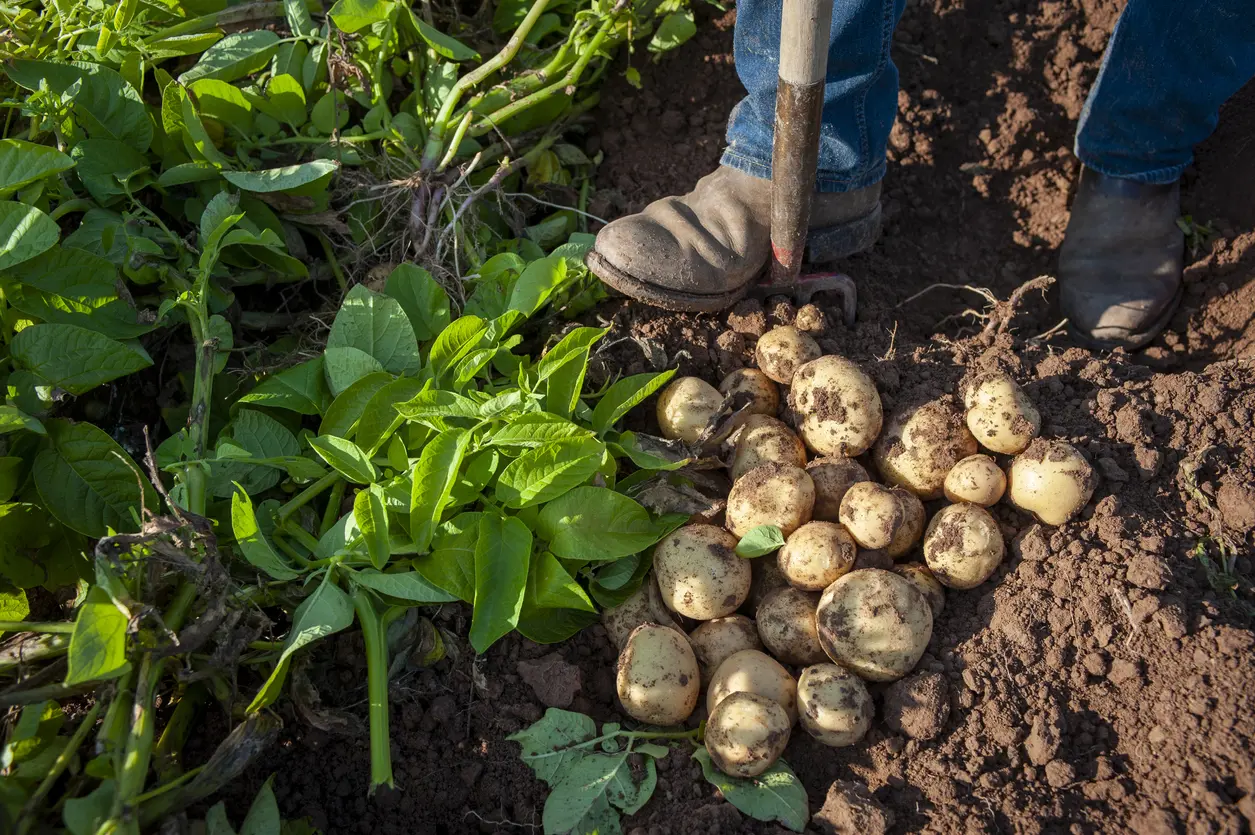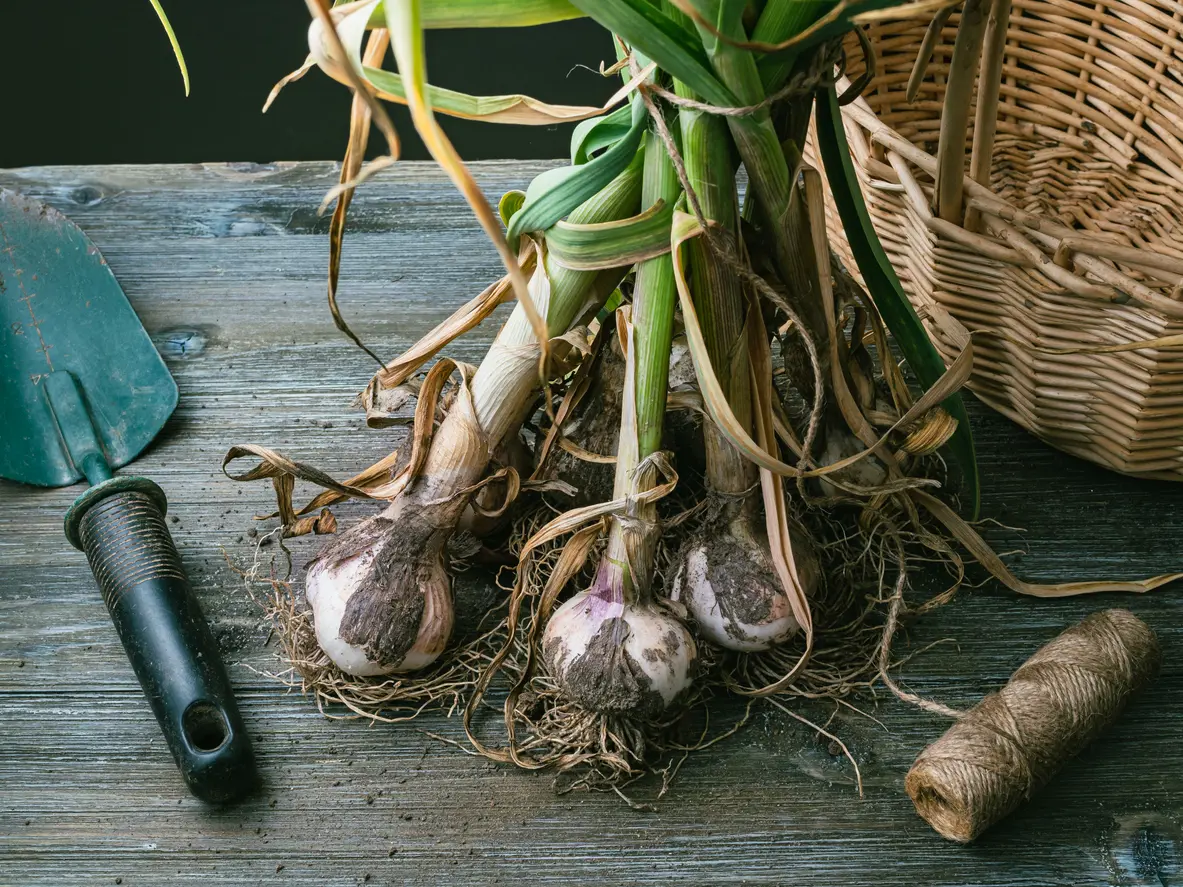How to Grow Tomatoes: A Care Guide from Planting to Harvesting

From tomato sauce to salsa to fresh and juicy fruit, tomatoes are a staple in many types of cuisine. Chefs and home cooks alike love nothing more than a fresh tomato off the vine. If you want something fresher than what the grocery stores can offer, you need to learn how to grow tomatoes at home.
This tomato planting guide covers everything from the best tomato varieties to how to get rid of troubling pests. You can grow tomatoes on your balcony or in a backyard, so take advantage of your space and start learning how to grow your own delicious produce with these tomato plant care tips.
Types of Tomatoes
Tomatoes come in all shapes and sizes. The big red ones are just the tip of the iceberg; they can even be purple and striped! Here are some tomato terms you need to know when choosing varieties:
- Indeterminate: These plants grow indefinitely and can take over a garden, but they produce tomatoes indefinitely.
- Determinate: These have a set size and grow all their tomatoes at once.
- Dwarf: They have a set size but produce fruit indefinitely.
- Heirloom: Heirloom tomatoes are pure varieties that have been saved from previous generations of plants.
- Hybrid: Hybrid tomatoes are crosses of two heirloom varieties. They’re often bred for specific purposes, such as size or disease resistance.
- Standard: This category has smooth, round fruits. Popular varieties include Better Boy and German Johnson.
- Salad: Salad tomatoes include pear, cherry, and grape varieties, available in determinate and indeterminate varieties.
- Paste: Ideal for making sauces and pastes, these tomatoes have thick flesh and fewer seeds. Common varieties include San Marzano, Roma, and Plum Regal. [1] Selecting the Best Tomato Varieties for Your Garden; NC State Extension Homegrown , [2] Recommended Cultivars and Types of Tomatoes for the Home Garden; Iowa State University Extension and Outreach
When choosing which tomatoes to grow, consider your entire space and resources to ensure the variety you choose will thrive in the area.
When and Where to Plant Tomatoes
Tomato plants thrive in the warm season but struggle when it gets too hot. Plant your tomatoes outdoors where they’ll get six to eight hours of sunlight each day. If afternoon temperatures get too hot, you may need to provide some shade. [5] Growing Tomatoes in the Home Garden; Dennis R. Pittenger, Nancy F. Garrison, Pamela M. Geisel, Carolyn L. Unruh; University of California
When to Sow Tomato Seeds
To make the most of the growing season, you should begin seeds indoors six to eight weeks before the last frost date. Pay close attention to local weather forecasts and estimated last frost dates, because starting them too soon could leave you with leggy plants that won’t perform as well.
Seeds grow best in soil temperatures that are 70-80 degrees Fahrenheit. Young and mature plants will thrive in temperatures ranging from 65 to 75 degrees Fahrenheit. Mid to late spring is usually the time to transplant tomato plants outside. [5] Growing Tomatoes in the Home Garden; Dennis R. Pittenger, Nancy F. Garrison, Pamela M. Geisel, Carolyn L. Unruh; University of California
Where to Plant Tomatoes
Learn how to grow tomatoes in pots and in the ground, and you can grow tomatoes virtually anywhere. They can go in the ground in a yard or in containers ranging from a five-gallon bucket to a raised bed.
Many people opt for raised beds even if they have the ground space because of all the benefits they offer. They’re easy to maintain and can save your back from aching after spending hours outdoors. Installing row covers is easy and allows you to grow tomatoes much longer. Since you don’t have to step on the soil, it won’t get compacted, and roots won’t struggle to access water and oxygen. [11] Raised Beds; UMass Extension
Research your tomato varieties thoroughly to determine where you can plant them for the best results. Indeterminate varieties won’t perform as well in containers in comparison to determinate varieties because they’re so large. [3] How to Grow Tomatoes; Royal Horticultural Society
Starting from Seeds vs. Buying Seedlings

Should you start your own plants from seed, or should you pick up young plants from the plant nursery? There are reasons you should and shouldn’t do either; it all depends on your situation and gardening preferences.
If you want to grow tomatoes you can’t find in grocery stores, starting seeds will be the way to go. You can buy seeds online from retailers offering rare varieties and impress all your gardening friends. However, you’ll have to plant them early enough to get a head start, but not so early that they become leggy.
If you don’t want the fuss of raising young tomato plants, buying seedlings when it’s time to transplant in the spring will be the easiest option. You’ll have little room for error, but you’ll have a severely limited selection to choose from. [3] How to Grow Tomatoes; Royal Horticultural Society , [5] Growing Tomatoes in the Home Garden; Dennis R. Pittenger, Nancy F. Garrison, Pamela M. Geisel, Carolyn L. Unruh; University of California
How to Start Seeds Indoors

If you start seeds indoors, you’ll need a sunny area in a south-facing window or grow lights. Choose a light soil mix ideal for starting seeds and keep the mix at 70 to 80 degrees Fahrenheit. You may need a heat mat to achieve this.
You don’t have to plant the seeds very deep; lightly cover them with soil and water them well. Keep the soil moist to ensure it never dries out. Maintain humidity by covering them with a plastic lid or bag.
Once they sprout, remove the cover and place them under your grow lights or in a sunny window. If they have to reach for sunlight, they could become leggy and weak. They’ll need up to eight hours of sunlight a day and will need the room temperature to be between 65 and 75 degrees Fahrenheit. [3] How to Grow Tomatoes; Royal Horticultural Society , [5] Growing Tomatoes in the Home Garden; Dennis R. Pittenger, Nancy F. Garrison, Pamela M. Geisel, Carolyn L. Unruh; University of California
Hardening Off Seedlings
Begin hardening off your seeds about 10 days before the transplant date. Take the plants you grew indoors and leave them out in the shade for a while. Bring them back in, and repeat the process again the next day, but increase their exposure to sunlight a little more each time. This process will adapt the plant to outdoor conditions so they can avoid transplant shock. [5] Growing Tomatoes in the Home Garden; Dennis R. Pittenger, Nancy F. Garrison, Pamela M. Geisel, Carolyn L. Unruh; University of California
Soil and Site Preparation
Tomatoes thrive in loamy soils that aren’t too sandy or clay-heavy; most average garden soil will work just fine. The ideal pH level should be 6.2 to 6.8 to keep the plants happy. [12] Balance Your Tomato Garden’s Soil pH and Fertilization for a Bountiful Homegrown Harvest; Joe Slusher; University of Georgia CAES Newswire
Tomatoes need sufficient nutrients to grow well, so ensure the ground is fertile before planting anything. You can get a soil test to check pH and nutrient levels. If you’re unable to do so, 4 inches of compost will help provide nutrients, keep soil temperatures steady, and prevent weeds from popping up.
If you’re going to grow in multiple raised beds, ensure there is at least 30 inches between each bed to ensure the plants will have enough room to spread out. If you want to grow in containers, make sure it’s at least five gallons so the roots will have plenty of space. [5] Growing Tomatoes in the Home Garden; Dennis R. Pittenger, Nancy F. Garrison, Pamela M. Geisel, Carolyn L. Unruh; University of California
How to Plant Tomatoes
Tomato plants will develop roots on any part of the stem that comes into contact with soil. To ensure your plants have healthy root systems, bury most of the plant. If a seedling seems strong and vigorous, you only need to bury it about 2 inches deeper than the starter pot’s soil line. If it’s weak and lanky, bury most of the plant sideways so only a few sets of leaves are sticking out from the top.
After planting, water the plants well to allow the soil to settle. Doing so will prevent air pockets in the ground. [5] Growing Tomatoes in the Home Garden; Dennis R. Pittenger, Nancy F. Garrison, Pamela M. Geisel, Carolyn L. Unruh; University of California
In the following weeks after transplanting, remove flowers from the plants to encourage them to focus on leaf production. Fruiting too early could cause the plant to become weak and not produce as well as it could have. [4] ips for Growing Tomatoes; Alicia Lamborn; University of Florida IFAS Extension
Caring for Tomato Plants
Once they’re planted in the ground, caring for tomato plants is pretty straightforward. It’s a matter of keeping the plants watered, fertilized, and supported.
Watering Tomatoes
Tomatoes typically need 1 to 2 inches of water each week, but it varies due to several factors. The plants will need more water on hot, sunny days, and will need less when it’s cool or cloudy. Older plants require much more water than young plants, and you’ll have to water container plants more often than in-ground plants. [3] How to Grow Tomatoes; Royal Horticultural Society , [4] ips for Growing Tomatoes; Alicia Lamborn; University of Florida IFAS Extension , [9] Greenhouse Tomato Production; Caroline Blanchard, Jeremy Pickens, Andre da Silva, Daniel Wells; Alabama A&M & Auburn Universities Extension
It’s important to give tomatoes long, deep drinks to encourage root growth and prevent problems. Plants given shallow drinks of water are more prone to blossom end rot because they lack calcium. [6] Key to Common Problems of Tomatoes; University of Maryland Extension
Mulching Tomatoes
The best way to keep your tomato plants happy is to offer them a hearty layer of mulch. 3 to 4 inches of compost will keep soil temperatures even, prevent water from evaporating, and reduce weeds. Don’t let the mulch touch the base of the plants to reduce waterborne diseases. [3] How to Grow Tomatoes; Royal Horticultural Society , [5] Growing Tomatoes in the Home Garden; Dennis R. Pittenger, Nancy F. Garrison, Pamela M. Geisel, Carolyn L. Unruh; University of California
Fertilizing Tomatoes

Avoid using too much nitrogen when fertilizing tomato plants. Nitrogen promotes leaf growth and will prevent the plants from developing flowers and fruits. A 10-10-10 fertilizer should suffice in most soils. If you’re able, get a soil test to analyze what your plants need for the best results.
Once your plants start developing fruit, give them potassium fertilizer every two weeks. Potassium encourages fruiting and will ensure your plants have the nutrients they need to give you a bountiful harvest. [3] How to Grow Tomatoes; Royal Horticultural Society , [5] Growing Tomatoes in the Home Garden; Dennis R. Pittenger, Nancy F. Garrison, Pamela M. Geisel, Carolyn L. Unruh; University of California
Supporting Tomatoes
Tomato plants will need support unless they’re a compact determinate variety. There are two types to consider: caging and staking.
Factors to consider with caging include:
- Cages have a set size and work well for determinate tomato plants.
- Cages can make pruning harder, so it’s better to start using them when the plants produce fruit.
- Cages are typically 3 to 6 feet tall, so they won’t work well with large plants.
Factors to consider with staking include:
- Stakes can adapt to any size plant, allowing you to grow large indeterminate varieties.
- Stakes can work with plants that have up to four main stems.
- You can use cloth strips, twine, or clips to keep plants attached to the stakes.
- Staked plants require more pruning.
You can combine the methods and use stakes to support cages if your plants grow larger than you expected or topple over in the wind. [5] Growing Tomatoes in the Home Garden; Dennis R. Pittenger, Nancy F. Garrison, Pamela M. Geisel, Carolyn L. Unruh; University of California , [8] Pruning, Training, and Supporting Tomatoes; Dr. Francis J. Ferrandino; The Connecticut Agricultural Experiment Station
Pruning and Training Tomato Plants

Indeterminate tomato plants need frequent pruning to prevent them from becoming unruly, but determinate plants also benefit from pruning. These plants can grow wild in their first month, doubling in size every two weeks. It’s crucial to prune the unnecessary parts so you don’t end up with a jungle of tomato vines.
Tomato plants make sugar, and when a branch can’t use any more sugar, it signals to the plant that it’s time to make a new plant. That’s when it will develop suckers, the little branches at a 45-degree angle between the main stem and smaller branches.
Remove these suckers by gently picking them off the plant as soon as you spot them. It will keep the plants focused on the main portions and reduce the spread of diseases. [8] Pruning, Training, and Supporting Tomatoes; Dr. Francis J. Ferrandino; The Connecticut Agricultural Experiment Station
Common Pests and Diseases
You’re bound to come across these tomato growing problems at some point in the season:
- Aphids: These sap-sucking pests will drink your plants dry while hiding underneath leaves. Spray them off with water or grow flowers to attract their natural enemy: the ladybug.
- Blossom end rot: If tomato plants don’t receive enough calcium, their fruits will develop dark spots on the ends.
- Early blight: Also called alternaria leaf spot, this disease leaves bull’s-eye-shaped lesions all over the plant. It’s a fungal disease easily spread by rain or splashing water. Water at the base, keep plants pruned, and remove diseased portions of the plant.
- Southern blight: This fungal disease can cause an entire plant to wilt and die. Remove these plants immediately, or your entire tomato garden could suffer.
- Tomato hornworms: Perhaps the most hated tomato pest, these large green worms will eat, and eat, and eat! Remove them by hand and allow the wasp parasitoid to kill them off for you. [6] Key to Common Problems of Tomatoes; University of Maryland Extension
When and How to Harvest Tomatoes
It’s important to know when to harvest tomatoes so you can enjoy your hard work. A tomato is ripe when it’s at its full color, whether it be red, yellow, orange, pink, purple, or green. Learn about the varieties you choose so you can know what to look for. [2] Recommended Cultivars and Types of Tomatoes for the Home Garden; Iowa State University Extension and Outreach
Unripened green tomatoes will never ripen off the vine. Once they hit the breaker stage, where green begins turning to yellow, you can harvest tomatoes, and they’ll ripen off the vine because they have everything they need to reach their full color. Ripen breaker tomatoes on the counter in the kitchen, or put them in the fridge to slow down their ripening process. [7] How to Store Tomatoes; Susan Himes; Texas A&M AgriLife
Harvest tomatoes by gently pulling them off the vine with the stalk intact. If you struggle, use a clean, sharp pair of gardening shears to cut them off the plant. [3] How to Grow Tomatoes; Royal Horticultural Society
Post-Harvest Tips
It’s a common mistake to store tomatoes in the refrigerator, but doing so can negatively affect the flavor and texture of your tomatoes. It’s better to store them on the counter at room temperature to preserve their flavor. Of course, you can use the refrigerator if you have too many tomatoes to use all at once, but expect the flavor to change. [7]
For long-term storage, canning and freezing are viable options. You can use both of these methods to store homemade sauces and salsa for whole or quartered tomatoes. [10]
Was this article helpful?
-
Selecting the Best Tomato Varieties for Your Garden; NC State Extension Homegrown;
https://homegrown.extension.ncsu.edu/2021/09/05/selecting-the-best-tomato-varieties-for-your-garden/ -
Recommended Cultivars and Types of Tomatoes for the Home Garden; Iowa State University Extension and Outreach;
https://yardandgarden.extension.iastate.edu/how-to/recommended-cultivars-and-types-tomatoes-home-garden -
How to Grow Tomatoes; Royal Horticultural Society;
https://www.rhs.org.uk/vegetables/tomatoes/grow-your-own -
ips for Growing Tomatoes; Alicia Lamborn; University of Florida IFAS Extension;
https://sfyl.ifas.ufl.edu/media/sfylifasufledu/baker/docs/pdf/horticulture/Tips-for-Growing-Tomatoes.pdf -
Growing Tomatoes in the Home Garden; Dennis R. Pittenger, Nancy F. Garrison, Pamela M. Geisel, Carolyn L. Unruh; University of California;
https://anrcatalog.ucanr.edu/pdf/8159.pdf -
Key to Common Problems of Tomatoes; University of Maryland Extension;
https://extension.umd.edu/resource/key-common-problems-tomatoes/ -
How to Store Tomatoes; Susan Himes; Texas A&M AgriLife;
https://agrilifetoday.tamu.edu/2024/06/18/how-to-store-tomatoes/ -
Pruning, Training, and Supporting Tomatoes; Dr. Francis J. Ferrandino; The Connecticut Agricultural Experiment Station;
https://portal.ct.gov/-/media/caes/documents/publications/fact_sheets/plant_pathology_and_ecology/pruningtrainingandsupporitngtomatoesferrandinopdf.pdf?rev=4b8b15da43b3459c832c9a29d80e67c5&hash=A400FF8864A2E66B17B0AD72C0530B3F -
Greenhouse Tomato Production; Caroline Blanchard, Jeremy Pickens, Andre da Silva, Daniel Wells; Alabama A&M & Auburn Universities Extension;
https://www.aces.edu/blog/topics/crop-production/greenhouse-tomato-production/ -
Canning and Freezing Tomatoes and Making Salsa; North Dakota State University;
https://www.ndsu.edu/agriculture/extension/publications/canning-and-freezing-tomatoes-and-making-salsa -
Raised Beds; UMass Extension;
https://www.umass.edu/agriculture-food-environment/sites/ag.umass.edu/files/fact-sheets/pdf/raised_beds.pdf -
Balance Your Tomato Garden’s Soil pH and Fertilization for a Bountiful Homegrown Harvest; Joe Slusher; University of Georgia CAES Newswire;
https://newswire.caes.uga.edu/story/5822/homegrown-tomatoes.html






